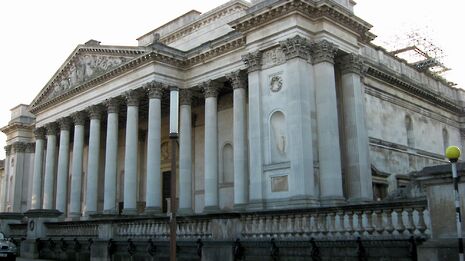Exhibition: Following Hercules
Emer O’Hanlon reviews the Fitzwilliam Museum’s ongoing exhibition

The Fitzwilliam Museum’s ‘Following Hercules: The Story of Classical Art’ is an engaging exhibition focused on a simple idea. Through a comprehensive selection of items, all featuring Hercules in some form or another, we are told the story of the depiction of form in classical art and its defining impression on the history of Western sculpture. The intimate octagonal space of the Fitzwilliam Museum’s Gallery 10 provides a perfect setting for the whistle-stop tour that ‘Following Hercules’ treats us to. The diversity of the objects on display exemplifies Hercules’ widespread representation and appeal – among others we have vases, bronzes, coins, seal rings, sketches, engravings, paintings and porcelains.
The items range from the classical to the modern, and show us that while ancient, classical art has always had relevance for artists that continues to this day. The exhibits themselves are very well-chosen. For example, the Farnese Hercules, an ancient statue discovered in Rome in 1546, was an important source of inspiration for many of the artists showcased in this exhibition; in the absence of having the actual statue, there are a number of sketches and representations on display to give a sense of it. The most impressive of these is Goltzius’ 1592 engraving of the Farnese Hercules, which embodies the majesty, fascination and presence of that portrait type, a wonderfully evocative substitute for the real thing.
The exhibition highlights the special relationship of Hercules with Cambridge itself, and with the Fitzwilliam museum in particular. In 1850, the museum acquired thirty plaster casts of Classical statues, of which the Farnese Hercules was the largest and most impressive. All of these casts, including the Farnese Hercules, now reside in the Museum of Classical Archaeology at the Faculty of Classics. It was nice to see the interplay here between the different museums in Cambridge, particularly with the current ‘Beauty and Balance’ display, which re-creates key arrangements from Kettle’s Yard. Last but by no means least, the centrepiece of ‘Following Hercules’ takes the form of a colossal laser-cut polystyrene statue by Cambridge-born artist Matthew Darbyshire.
Darbyshire is certainly not lacking in ideas, but I felt that many of these were lost – ironically – through the medium of the polystyrene itself. One of the joys of the depiction of Hercules throughout the history of art is the sheer diversity of the ways in which he has been shown – the exhibition showcases this very well. From the vigorous expression of the vase painting, to the drunken, almost Satyr-like air of the Etruscan bronzes and the wearied gaze of the Farnese type, ‘Following Hercules’ shows us that Hercules is a figure with which artists can experiment, to both serious and light-hearted degrees. It is a shame that the face of Darbyshire’s Hercules seems to have little in the way of expression; polystyrene doesn’t create shadows, and therefore the nuance that other materials are better placed to convey is lost. Also noticeably lacking from Darbyshire’s Hercules are the muscles and toning of his back, again an aspect which has been an longstanding source of fascination for artists. Far from being an oversight on Darbyshire’s part, these absences felt more like an unfortunate side effect of his choice of material.
Overall, I felt that the exhibition could have done more to explain the appeal of Hercules as a figure to artists throughout history, but in absence of this, the display ticks all the boxes. ‘Following Hercules’ does an excellent job in showing, through a small collection of items, that the dialogue between the contemporary and the classical has been an enduring and enriching one, one which has inspired, moulded and enlivened how we think about art today.
‘Following Hercules: The Story of Classical Art’ is on display at the Fitzwilliam Museum, Cambridge, 25th September-6th December 2015. Admission is free.
 News / Fitz students face ‘massive invasion of privacy’ over messy rooms23 April 2024
News / Fitz students face ‘massive invasion of privacy’ over messy rooms23 April 2024 News / Cambridge University disables comments following Passover post backlash 24 April 2024
News / Cambridge University disables comments following Passover post backlash 24 April 2024 Comment / Gown vs town? Local investment plans must remember Cambridge is not just a university24 April 2024
Comment / Gown vs town? Local investment plans must remember Cambridge is not just a university24 April 2024 Interviews / Gender Agenda on building feminist solidarity in Cambridge24 April 2024
Interviews / Gender Agenda on building feminist solidarity in Cambridge24 April 2024 Comment / Does Lucy Cavendish need a billionaire bailout?22 April 2024
Comment / Does Lucy Cavendish need a billionaire bailout?22 April 2024





